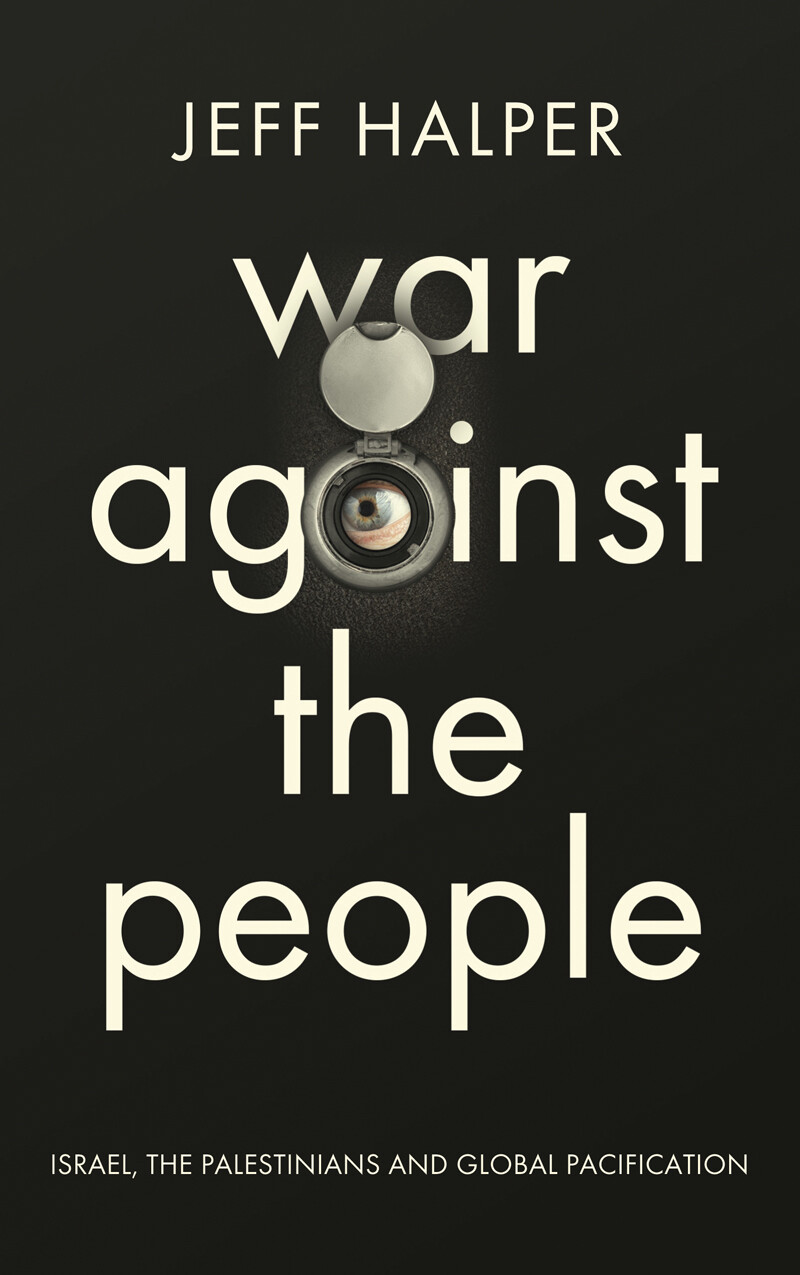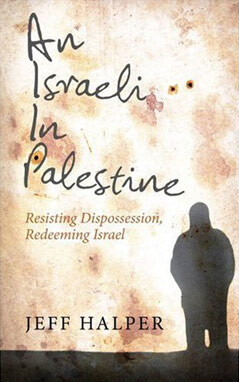The Electronic Intifada 2 October 2015

War Against the People: Israel, the Palestinians and Global Pacification by Jeff Halper (Pluto Press)
War Against the People is a genuinely frightening book. At its heart, author Jeff Halper provides an exhaustive survey of Israel’s weapons technology.
The reader is introduced to cyborg soldiers, radar systems that see through walls, a tank named Cruelty, a 20-gram drone in the shape of a butterfly, a stealth “wonder boat” called the Death Shark, a series of weapons named after insects or natural phenomena (bionic hornets, smart dust, dragonfly drones and smart dew robots), cybernetic insects, a 600-building “urban warfare” training center nicknamed Chicago and a one-megaton bomb containing electromagnetic pulse (EMP) capability.
The potential consequences of these weapons are devastating. Halper explains, for example, that if a bomb with EMP capability was detonated 400 kilometers over Iran and combined with cyber-attacks, it could knock out that country’s electric power grid, communications, oil refineries, transportation and food supplies.
Halper spent nearly 20 years as head of the Israeli Committee Against House Demolitions (ICAHD). His previous book, An Israeli in Palestine, opens with the destruction of his friend Salim Shawamreh’s home in Anata, a village near Jerusalem. This event forced Halper, who had been a committed Zionist, to confront what was really happening in the West Bank and Gaza.
A policy of detail
War Against the People represents a new stage in Halper’s thinking. He explains, “This book began with a question that many activists like myself have asked over the years: How does Israel get away with it?”
Edward Said, in his 1979 essay “Zionism from the Standpoint of its Victims,” tried similarly to understand why, when even Zionists conceded Israel’s colonialist principles or intrinsic unfairness, the situation did not shift in favor of the Palestinians. Said concluded that “Zionism’s effectiveness lay in its being a policy of detail.”
Halper’s answer too lies in Israel’s command of detail. He sets himself the task of comprehending Israel’s complex and often secretive role in global “security” politics, in which he argues that it has become a key player.
Halper lays out the aims and structure of what he calls the global pacification industry and its “securocratic wars.” The starting point is an assumption that the nature of warfare has changed, with the rise of “irregular” methods such as terrorism and an increasing “threat to societies from ‘below.’”
Halper quotes the British general Rupert Smith: “Our opponents are of and amongst the people — in the flesh and in the media — and it is there that the fight takes place.”
Yet, as Halper explains: “What stands at the heart of war amongst the people … is the integrated MISSILE Complex: Military, Internal Security, Surveillance, Intelligence-gathering and Law Enforcement. Seen in its securocratic form, war amongst the people is in fact war against the people.”
The occupation of Gaza and the West Bank is thus a resource for Israel, Halper suggests, allowing it to export high-tech weaponry that has been tested in pacifying a recalcitrant population. He posits that this allows Israel to thrive in what he otherwise calls a “decidedly post-colonial age” (which is, at best, an overstatement).
Halper also details Israel’s major weapons systems and outlines its mode of securocratic control over the Palestinians and how this method has been sold — openly and covertly — to regimes “on the peripheries of the world-system,” including in West Africa, South America and East Asia.
War Against the People demonstrates how the same weapons and tactics have been used by what Halper calls “core hegemonic” countries such as the UK and US. This includes the “Palestinianization” of Iraq in its occupation, in such features as the wall built around the Baghdad Green Zone, the temporary closure of towns and villages, targeted assassinations and the use of checkpoints and roadblocks to militarize the landscape.
Halper writes that a key element in securocratic wars is that the line between the military and police is blurred: “The fact that officers in the different police forces dealing with the Ferguson protests, who chose a confrontational approach backed up by heavy military equipment, were trained in Israel has led to a feeling that the people of Ferguson have been ‘Palestinianized.’”
What we’re up against
The question of how Israel gets away with it inevitably prompts another: Why does it want to? Halper quotes Israeli academic Yoram Peri, who suggests that Israel is motivated by “what is effectual in the international arena,” which is simply power.
It is one achievement of War Against the People that it acknowledges this realpolitik worldview and seeks to deconstruct it.
If in An Israeli in Palestine Halper sought to understand how unjust and immoral Israel’s policies are towards the Palestinians, in his new book he demonstrates how this use of power is also ineffective — and dangerous — on its own terms.
“Security” states have the effect of making their citizens insecure.
Halper’s book is aimed particularly at activists. He speaks collegially to this audience, apologizing for using language that is overly technical for “people like me (and probably you).” He claims that this level of technical detail is vital because “we cannot effectively resist militarism and attempts to securitize and pacify us if we don’t know what we’re up against.”
One weakness in Halper’s arguments results from the scale of his ambition. In order to understand Israel’s role in a “world-system” of pacification, he must explain that world to a potentially naive reader.
His conclusion that Israel has a “pivotal position along key axes” is largely persuasive. But it is sometimes unclear whether this is principally a book about global pacification, with Israel/Palestine as a key example, or a book about Israel’s place in the world. As the former, it inevitably feels partial and incomplete. Perhaps the book could have focused on one or two other countries in similar detail, thus sharpening the particularities of the Palestinian cause.
The phrase “the people” is meanwhile symptomatic of Halper’s slight tendency to generalize or overstate. For example, more attention was needed to how gender and age interact with location in how pacification is experienced. The violence done to men and women is invariably different in kind.
Yet the phrase “the people” also links Halper to a radical tradition, including to the work of the critic and essayist William Hazlitt. In Hazlitt’s 1817 essay “What is The People?” he begins by turning on his audience: “And who are you that ask the question?” To separate oneself from “the people,” Hazlitt recognized, is in itself an exercise of power. War Against the People poses similar challenges to the reader; there is nowhere to hide.
This is a brave, angry, unruly book, which inspires fear, but also hope.
Tom Sperlinger is the author of Romeo and Juliet in Palestine: Teaching Under Occupation, published by Zero Books.






Comments
Marketing
Permalink Anthony Shaker replied on
All this is just marketing for the sale of Israeli arms, which have been partly developed through stolen technologies, partly bought with American taxpayers' money. Israel has built its military infrastructure based on military principles that belong to another age. It used to face conventional armies led by "Arab" nationalist clowns, who started calling themelves "Arab" after being given that name by the English and the French. That age is long gone, thanks partly to Israel itself, and of course to its peril.
In any case, few of these "impressive" arms and bombs can serve Israel in a future war, which it is itching to wage in order to draw in the United States and complete the destruction of Palestine along with the Middle East.
This is the fantasy of this vile Zionist race colony, which little realizes that no state can behave in this way and stay intact. It is now clear that Israel has no future in this region, and it will not be able to avoid the fate of the Crusaders' colony, as it approaches nearly the same conditions that existed centuries ago. The mayhem then was only the eye of the storm, the historical precondition for the exit.
Jeff Halper's 'War Against the People'
Permalink Dr Brian Robinson replied on
As I read this book, I’m thinking of the complete disconnect between the picture of the real Israel that emerges from it, and the delusional, idealised, romanticised fantasy-image of the divinely ordained ancestral homeland beloved of apologists for Israel and those for whom its worship has become synonymous with Judaism, almost a substitute for God.
Perhaps the most basic idea I'm left with is simply the shocking thought that Israel doesn’t want peace, has too much going for its investment in perpetual violence, has too much to lose now by opting for the peace and security that it could still have, if only.
Jeff Halper's 'War Against the People'
Permalink Rupert Small replied on
Dr Brian Robinson
You have hit upon one of the fundamental positions and strengths of Israel and particularly it's relationship with the West (read USA): sentimentality. A very powerful and insidious force.